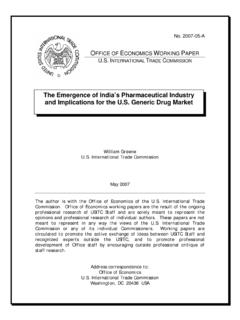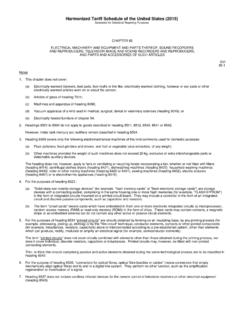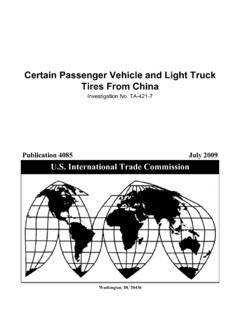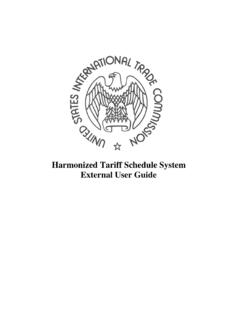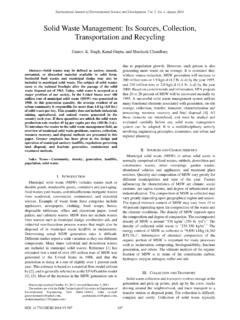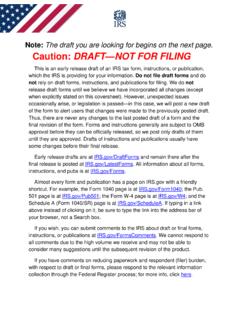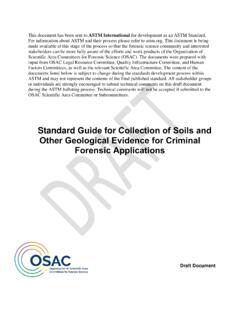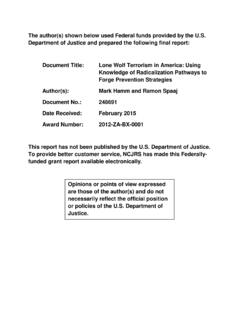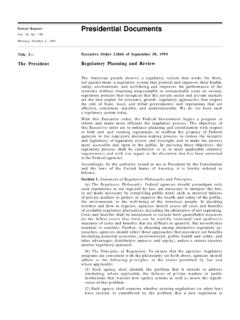Transcription of Digital Trade in the U.S. and Global Economies, Part 2
1 United States International Trade Commission Digital Trade in the and Global Economies, Part 2 August 2014 Publication Number: 4485 Investigation Number: 332-540 United States International Trade Commission Commissioners Meredith M. Broadbent, Chairman Dean A. Pinkert, Vice Chairman Irving A. Williamson David S. Johanson F. Scott Kieff Rhonda K. Schmidtlein Robert B. Koopman Director, Office of Operations Nannette Christ Acting Director, Office of Economics Address all communications to Secretary to the Commission United States International Trade Commission Washington, DC 20436 United States International Trade Commission Digital Trade in the and Global Economies, Part 2 August 2014 Publication Number: 4485 Investigation Number.
2 332-540 United States International Trade Commission This report was prepared principally by Project Leader James Stamps Deputy Project Leader David Coffin Office of Economics Lin Jones, David Riker, Darren Sheets, Ravinder Ubee, and Bennet Voorhees Office of Industries Caitlin Blair, Sharon Ford, Eric Forden, Martha Lawless, Jeanette Leary, Katherine Linton, Kathryn Lundquist, Elizabeth Nesbitt, Erick Oh, Jeffrey Okun-Kozlowicki, George Serletis, Michael Stanton-Geddes, and Isaac Wohl Office of the General Counsel William Gearhart Content Reviewers Jose Signoret and Alan Treat Statistical Reviewers David Lundy, John Stephens, and Jeremy Wise Editorial Reviewer Peg Hausman Administrative Support Phyllis Boone, Trina Chambers, and Monica Reed Special Assistance Yasnanhia Cabral, Eleanor Coates, William Greene, Jeffrey Horowitz, Cynthia Payne, Jennifer Powell, and Alissa Tafti Help Desk and Customer Service Division Under the direction of Arona Butcher, Chief Country and Regional Analysis Division Office of Economics Abstract At the request of the Senate Committee on Finance, the International Trade Commission ( Commission )
3 Undertook an investigation to better understand the role of Digital Trade domestic commerce and international Trade conducted via the Internet in the and Global economies, as well as the effects of barriers and impediments to Digital Trade that impede access to Global markets. The Commission s analysis provides findings at three levels: at the firm level, through 10 case studies; at the industry level, through a survey of businesses; and at the economy-wide level, using computable general equilibrium and econometric models. This analysis shows that Digital Trade contributes to economic output by improving productivity and reducing Trade costs. Digital Trade also contributes to the economy as a whole as it facilitates communication, expedites business transactions, improves access to information, and improves market opportunities for small and medium-sized enterprises (SMEs).
4 Digital Trade s combined effects of increased productivity and lower Trade costs are estimated to have increased real gross domestic product (GDP) by $ $ billion ( percent), and increased aggregate employment by to million full-time equivalents ( to percent). These estimates of the effects of Digital Trade are not exhaustive, however, as other effects of Digital Trade were not captured in these findings. According to survey results, firms in digitally intensive industries sold $ billion in products and services online in 2012, including $ billion in exports; they purchased $ billion in products and services online in 2012, including $ billion in imports.
5 Online sales by SMEs in digitally intensive industries totaled $ billion in 2012. However, the Commission s analysis suggests that foreign Trade barriers are having discernible effects on Digital Trade . According to the Commission s econometric estimates, removing these barriers would increase the real GDP by an estimated $ $ billion ( percent). 1 2 Table of Contents Abstract .. 1 Abbreviations and Acronyms .. 10 Executive Summary .. 13 Chapter 1 Introduction .. 27 Objective .. 28 Scope .. 29 Definition of Digital Trade .. 29 Industries Particularly Involved in Digital Trade .. 30 Approach .. 31 Firm-level Findings: Case Studies .. 32 Industry-level Findings: Survey of Firms.
6 32 Economy-wide Findings: Quantitative Assessments .. 33 Other Information Sources .. 34 Organization of the Report .. 34 Bibliography .. 36 Chapter 2 Digital Trade and Businesses: Domestic Operations and International Trade .. 39 Key Findings .. 39 Results .. 40 Estimate of Digital Trade in the Economy .. 41 Online Sales of Products and Services .. 41 Online Purchases of Products and Services .. 45 International Trade .. 47 Business Practices .. 50 Advertising .. 54 Online Advertisements .. 54 Cyber Incidents .. 58 Bibliography .. 61 Chapter 3 Broader Linkages and Contributions of Digital Trade to the Economy .. 65 Key Findings .. 65 Analytic Approach and Data Sources.
7 66 Economic Benefits of Increased Productivity due to the Internet .. 67 The Contribution of the Internet to 67 Economy-Wide Implications of the Productivity Effects of the Internet .. 70 Economic Benefits of Reduced International Trade Costs due to the Internet .. 72 Simulations That Combine the Two Types of Effects .. 73 Bibliography .. 76 Chapter 4 Barriers to International Digital Trade and Their Economic Effects .. 77 Key Findings .. 77 Firms Assessments of Barriers to International Digital Trade .. 79 Approach .. 80 Localization Requirements .. 81 3 Market Access Limitations .. 86 Data Privacy and Protection Requirements .. 88 IPR Infringement .. 92 Uncertain Legal Liability.
8 95 Censorship .. 97 Customs Requirements .. 99 Estimated Effects of Removing Digital Trade Barriers .. 100 Survey Results: Effects of Barriers on Sales Abroad .. 100 Survey Results: Barriers Rankings by Country .. 102 Estimated Economy-wide Effects of Removing foreign Barriers to Digital Trade .. 102 Bibliography .. 105 Chapter 5 Case Studies: How Digital Trade Creates New Opportunities for Businesses and Consumers .. 109 Case Study 1: Enabling Independent Creators in the Content Industries .. 112 Challenges for SMEs within the Traditional Pre-Internet Industry 113 Internet Technologies Are Lowering Barriers to Entry for SMEs .. 114 Bottom Line for Content Creators and Consumers.
9 122 Case Study 2: Facilitating Greater Capacity Utilization in the Travel and Lodging Industry .. 124 Background .. 125 The Internet s Impact on the Direct Sales Channels .. 125 The Internet s Impact on Intermediary Sales Channels .. 126 The Internet s Impact on Capacity Utilization .. 127 The Internet and Private Capacity Utilization .. 128 Case Study 3: How the Internet Reduces Job Search Frictions and Lowers Unemployment .. 131 Case Study 4: Increasing Collaboration and Integration in Online Services The Economic Contributions of Application Programming Interfaces .. 133 Benefits to Businesses from Using APIs .. 134 End-User (Consumer) Benefits .. 137 Challenges and Concerns.
10 138 Bibliography .. 139 Chapter 6 Case Studies: The Rise of Big Data .. 151 Case Study 5: Data Analytics Innovations in the Insurance Industry .. 153 Competitive Drivers for Adopting Advanced Data Analytics in Insurance .. 154 Case Study 6: Machine-to-Machine (M2M) Communication Is Improving Production Processes .. 159 Benefits of M2M Communication .. 160 Examples of How Firms Use M2M Communication to Increase Efficiency .. 161 Risks and Vulnerabilities of the Internet of Things .. 163 Case Study 7: Digital Innovations in Agriculture .. 164 M2M Communications-based Packages Delivering Agricultural Solutions .. 165 Growing Use of Unmanned Aerial Vehicles (UAVs).
